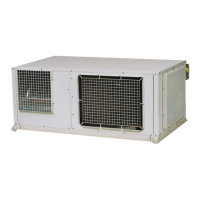18
PIPING AND REFRIGERANT CHARGE
- Fully open the gas line stop valve, and slightly open
the liquid line stop valve.
- Charge refrigerant by opening the gauge manifold
valve.
- Charge the required refrigerant within the difference
range of ±0.5kg by operating the system in cooling.
- Fully open the liquid line stop valve after completing
refrigerant charge.
- Continue cooling operation for more than 10 minutes
to circulate the refrigerant.
- Remove the “close” plate from the stop valve and
hook the attached “Open” plate at the stop valve.
.
Example of Evacuation and Refrigerant Charge for FSN
NOTE:
- Charge the refrigerant correctly after calculation.
Overcharge and insufficient charge of the refrigerant may
cause the compressor failure. Insulate the liquid pipe for
prevention of the capacity decrease according to the
ambient air conditions and the dewing on the pipe
surface by the low pressure.
- Check to ensure that there is no gas leakage. When
large amount of the refrigerant leaks, the troubles as
follows may occur:
- Oxygen deficiency
- Generation of Harmful gas Due to Chemical Reaction
with fire.
- Use thick gloves to protect your hands from liquid
refrigerant injuries when handling refrigerant.
CAUTION:
Check for refrigerant leakage in detail. If a large
refrigerant leakage occurs, it will cause difficulty with
breathing or harmful gases would occur if a fire was
being used in the room. An excess or a shortage of
refrigerant is the main cause of trouble to the units.
Charge the correct refrigerant quantity.
Insulate Pipes
Insulate the refrigerant pipes as shown below
After connecting the refrigerant piping, seal the refrigerant
pipes by using the field-supplied insulation material.
Insulate the unions and flare-nuts at the piping connections
completely. Insulate the liquid piping and gas piping
completely to avoid decreasing of performance and dewing
on the surface of the pipe.
CAUTION:
Cap the end of the pipe when the pipe is to be
inserted through a hole.
Do not place pipes on the ground directly without
attaching a cap or vinyl tape to the ends.
Stop Valve
Operation of the stop valve should be performed according
to the below figure.
Nitrogen tank
(For Air Tight Test &
Nitrogen Blow during
Brazing)
Charging
Cylinder
Vacuum Cylinde
Gas (High) Line
Liquid Line
Oil trap is recommended
at every Ht meters lift
Liquid Stop valve
Gas (Low) Line Stop valve
Indoor Unit
Indoor Unit
Multi-Kit
Outdoor Units
Gas (Low) Line
Stop Valve
Insulation
(Field Supply)
Refrigerant
Piping
(Field Supply)
Correct Incorrect
Hexagonal Wrench
(To open or close
spindle valve)
Ref. Pressure
Refrigerant
Piping
O-Ring
(rubber)
Check Joint
(Only the charging hose
can be connected. Tighten
the cap with a torque of
9.8 N·m
Sindle Valve
Counterclockwise...
open Clockwise...
Close Closed before shipment
Cap
(Tighten the cap with
a torque below.
ttach this after work)

